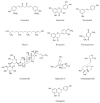Natural Product-based Nanomedicine: Recent Advances and Issues for the Treatment of Alzheimer's Disease
- PMID: 34923947
- PMCID: PMC9881085
- DOI: 10.2174/1570159X20666211217163540
Natural Product-based Nanomedicine: Recent Advances and Issues for the Treatment of Alzheimer's Disease
Abstract
Alzheimer's disease (AD) affects the elderly and is characterized by progressive neurodegeneration caused by different pathologies. The most significant challenges in treating AD include the inability of medications to reach the brain because of its poor solubility, low bioavailability, and the presence of the blood-brain barrier (BBB). Additionally, current evidence suggests the disruption of BBB plays an important role in the pathogenesis of AD. One of the critical challenges in treating AD is the ineffective treatments and their severe adverse effects. Nanotechnology offers an alternative approach to facilitate the treatment of AD by overcoming the challenges in drug transport across the BBB. Various nanoparticles (NP) loaded with natural products were reported to aid in drug delivery for the treatment of AD. The nano-sized entities of NP are great platforms for incorporating active materials from natural products into formulations that can be delivered effectively to the intended action site without compromising the material's bioactivity. The review highlights the applications of medicinal plants, their derived components, and various nanomedicinebased approaches for the treatment of AD. The combination of medicinal plants and nanotechnology may lead to new theragnostic solutions for the treatment of AD in the future.
Keywords: Alzheimer’s disease; amyloid-β; blood-brain barrier; drug delivery; nanoparticles; phytochemicals.
Copyright© Bentham Science Publishers; For any queries, please email at epub@benthamscience.net.
Figures


References
-
- Mohsen H., El-Dahshan E-S.A., El-Horbaty E-S.M., Salem A-B.M. Classification of brain MRI for Alzheimer’s disease based on linear discriminate analysis. Egyptian Comput Sci J. 2017;41(3):44–52.
-
- Prince M., Wimo A., Guerchet M., Ali G.C., Wu Y.T., Prina M. The global impact of dementia: An analysis of prevalence, incidence, cost and trends. 2015;2015
-
- Hampel H., Mesulam M.M., Cuello A.C., Farlow M.R., Giacobini E., Grossberg G.T., Khachaturian A.S., Vergallo A., Cavedo E., Snyder P.J., Khachaturian Z.S. The cholinergic system in the pathophysiology and treatment of Alzheimer’s disease. Brain. 2018;141(7):1917–1933. doi: 10.1093/brain/awy132. - DOI - PMC - PubMed
MeSH terms
Substances
LinkOut - more resources
Full Text Sources
Medical
Miscellaneous

